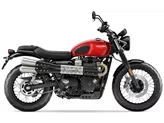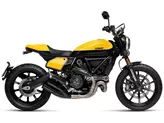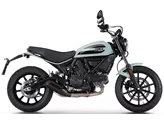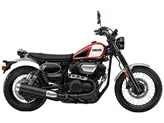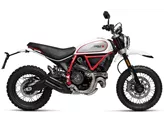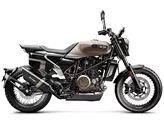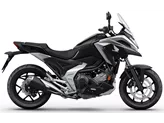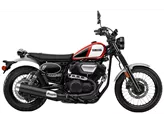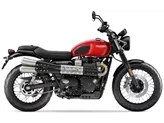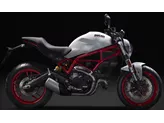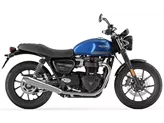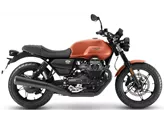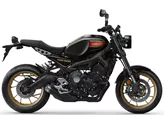Yamaha SCR950 2017 vs. Ducati Scrambler Icon 2021

Yamaha SCR950 2017
Ducati Scrambler Icon 2021
Overview - Yamaha SCR950 2017 vs Ducati Scrambler Icon 2021
The Yamaha SCR950 2017 and the Ducati Scrambler Icon 2021 are both naked bikes with a scrambler aesthetic. They share similarities in terms of engine type, fuel system, cooling, and number of cylinders. However, there are notable differences in their technical specifications and overall performance.
In terms of engine power, the Ducati Scrambler Icon 2021 takes the lead with 73 HP compared to the Yamaha SCR950 2017's 52 HP. However, the Yamaha model offers higher torque at 79.5 Nm compared to the Ducati's 66.2 Nm. Both bikes feature fuel injection systems, ensuring efficient fuel delivery.
The suspension systems of these bikes differ slightly. The Yamaha SCR950 2017 is equipped with a telescopic fork in the front and a swing arm with dual shocks in the rear, both made of steel. On the other hand, the Ducati Scrambler Icon 2021 features an upside-down telescopic fork in the front and a swing arm with a monoshock in the rear, with the swing arm made of aluminum. This variation in materials may contribute to differences in weight and handling.

Yamaha SCR950 2017
Both bikes have steel frames, but the Yamaha SCR950 2017 has a double cradle frame type, while the Ducati Scrambler Icon 2021 has a tubular frame type. The choice of frame type can affect the overall rigidity and stability of the bike.
In terms of braking, both bikes feature single disk brakes in the front. However, the Ducati Scrambler Icon 2021 has a larger diameter front disk at 330 mm, providing potentially better stopping power compared to the Yamaha SCR950 2017's 298 mm front disk.
The Yamaha SCR950 2017 comes with ABS as an advanced rider assistance system, providing added safety during braking. In comparison, the Ducati Scrambler Icon 2021 offers cornering ABS, which enhances safety during cornering maneuvers.
When it comes to dimensions and weights, the Yamaha SCR950 2017 has a wider front tire at 100 mm compared to the Ducati Scrambler Icon 2021's 110 mm. The Yamaha model also has a larger rear tire width at 140 mm, while the Ducati model has a wider rear tire at 180 mm. The Yamaha SCR950 2017 has a longer wheelbase at 1575 mm, providing potentially better stability. However, the Ducati Scrambler Icon 2021 has a lower seat height at 798 mm, which may be more suitable for riders with shorter inseams. The Yamaha SCR950 2017 is heavier with a kerb weight of 252 kg compared to the Ducati Scrambler Icon 2021's 189 kg. Both bikes have similar fuel tank capacities, with the Yamaha model at 13 l and the Ducati model at 13.5 l.
Ducati Scrambler Icon 2021
In terms of strengths, the Yamaha SCR950 2017 offers a credible scrambler look, comfortable seating position, powerful engine, adequately dimensioned brakes, and uncomplicated handling. Similarly, the Ducati Scrambler Icon 2021 boasts a classic Ducati V2 engine with air cooling, comfortable seating position, easy handling, cornering ABS as standard, and a superb scrambler look.
However, the Yamaha SCR950 2017 has some weaknesses. It lacks electronic features aside from ABS, and its chassis may not be as durable. Additionally, it has comparatively little lean angle clearance. On the other hand, the Ducati Scrambler Icon 2021 has fittings that may be poorly readable and is generally not considered cheap.
Overall, both the Yamaha SCR950 2017 and the Ducati Scrambler Icon 2021 have their own strengths and weaknesses. The choice between the two will depend on the rider's preferences and priorities, whether it be power, handling, safety features, or aesthetics.
Technical Specifications Yamaha SCR950 2017 compared to Ducati Scrambler Icon 2021
Pros and Cons in comparison
Pros and Cons in comparison
Yamaha SCR950 2017

The new SCR950 further expands the wide range of "Faster Sons" retro bikes. A visually extremely successful, minimalist bike with beautiful scrambler elements. When riding on asphalt, you only notice that the XV950 cruiser serves as the basis because of the low lean angle. The engine, on the other hand, pulls well and the brakes, each with a 298 disc at the front and rear, make a good effort. Off-road, however, the suspension elements quickly snap due to the high weight of 252 kilos. All in all, an interesting and very finely executed interpretation of a very early scrambler.
Ducati Scrambler Icon 2021
While the many different motorbike genres are becoming increasingly blurred and overlapping, the Ducati Scrambler Icon is indeed the uncomplicated and robust scrambler promised in its name. The wide handlebars make for unbelievably easy handling, so it's easy to forgive the fact that the comfort-oriented chassis has no adjustable fork, while the shock absorber can at least be adjusted in rebound and spring preload. You also forgive the fact that the front single disc needs quite a bit of manual force; after all, it is very commendable that a cornering ABS is fitted as standard. The rest of the equipment, however, is again in keeping with the minimalist style, which is perhaps even a little exaggerated in the case of the (outdated) LCD instruments. All in all, however, the Scrambler Icon convinces above all with its successful appearance, which conveys what it's all about even when stationary: lifestyle instead of riding style!
Price Comparison Avarage Market Price Yamaha SCR950 vs Ducati Scrambler Icon
There are a few key differences between a Yamaha SCR950 2017 and a Ducati Scrambler Icon 2021. In terms of price, the actual average price of a Ducati Scrambler Icon 2021 is about 11% higher. A Yamaha SCR950 2017 experiences a loss of 600 USD in one year and 1,480 USD in two years of ownership. This is offset by a loss of 1,520 USD and 1,430 USD for a Ducati Scrambler Icon 2021. There are the same number of bikes of both models available on the 1000PS.de marketplace, specifically 4. It takes less time to sell a Ducati Scrambler Icon with 128 days compared to 185 days for the Yamaha SCR950. Since model year 2017 1000PS.de editors have written 8 reviews for the Yamaha SCR950 and 30 reviews for the Ducati Scrambler Icon since model year 2015. The first review for the Yamaha SCR950 was published on 10/4/2016 and now has more than 26,500 views. This compares to more than 25,400 views for the first review on Ducati Scrambler Icon published on 10/1/2014.

